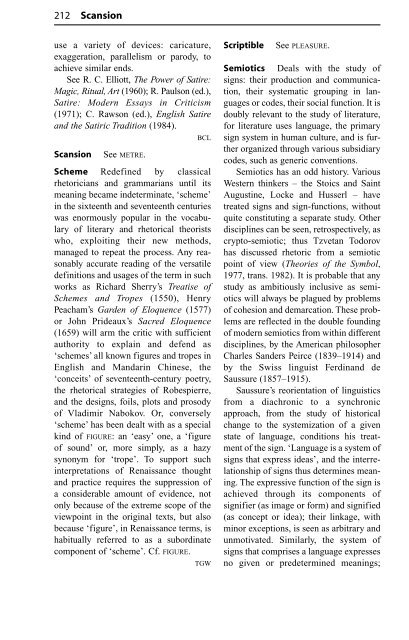The Routledge Dictionary of Literary Terms
The Routledge Dictionary of Literary Terms
The Routledge Dictionary of Literary Terms
Create successful ePaper yourself
Turn your PDF publications into a flip-book with our unique Google optimized e-Paper software.
212 Scansion<br />
use a variety <strong>of</strong> devices: caricature,<br />
exaggeration, parallelism or parody, to<br />
achieve similar ends.<br />
See R. C. Elliott, <strong>The</strong> Power <strong>of</strong> Satire:<br />
Magic, Ritual, Art (1960); R. Paulson (ed.),<br />
Satire: Modern Essays in Criticism<br />
(1971); C. Rawson (ed.), English Satire<br />
and the Satiric Tradition (1984).<br />
BCL<br />
Scansion See METRE.<br />
Scheme Redefined by classical<br />
rhetoricians and grammarians until its<br />
meaning became indeterminate, ‘scheme’<br />
in the sixteenth and seventeenth centuries<br />
was enormously popular in the vocabulary<br />
<strong>of</strong> literary and rhetorical theorists<br />
who, exploiting their new methods,<br />
managed to repeat the process. Any reasonably<br />
accurate reading <strong>of</strong> the versatile<br />
definitions and usages <strong>of</strong> the term in such<br />
works as Richard Sherry’s Treatise <strong>of</strong><br />
Schemes and Tropes (1550), Henry<br />
Peacham’s Garden <strong>of</strong> Eloquence (1577)<br />
or John Prideaux’s Sacred Eloquence<br />
(1659) will arm the critic with sufficient<br />
authority to explain and defend as<br />
‘schemes’ all known figures and tropes in<br />
English and Mandarin Chinese, the<br />
‘conceits’ <strong>of</strong> seventeenth-century poetry,<br />
the rhetorical strategies <strong>of</strong> Robespierre,<br />
and the designs, foils, plots and prosody<br />
<strong>of</strong> Vladimir Nabokov. Or, conversely<br />
‘scheme’ has been dealt with as a special<br />
kind <strong>of</strong> FIGURE: an ‘easy’ one, a ‘figure<br />
<strong>of</strong> sound’ or, more simply, as a hazy<br />
synonym for ‘trope’. To support such<br />
interpretations <strong>of</strong> Renaissance thought<br />
and practice requires the suppression <strong>of</strong><br />
a considerable amount <strong>of</strong> evidence, not<br />
only because <strong>of</strong> the extreme scope <strong>of</strong> the<br />
viewpoint in the original texts, but also<br />
because ‘figure’, in Renaissance terms, is<br />
habitually referred to as a subordinate<br />
component <strong>of</strong> ‘scheme’. Cf. FIGURE.<br />
TGW<br />
Scriptible See PLEASURE.<br />
Semiotics Deals with the study <strong>of</strong><br />
signs: their production and communication,<br />
their systematic grouping in languages<br />
or codes, their social function. It is<br />
doubly relevant to the study <strong>of</strong> literature,<br />
for literature uses language, the primary<br />
sign system in human culture, and is further<br />
organized through various subsidiary<br />
codes, such as generic conventions.<br />
Semiotics has an odd history. Various<br />
Western thinkers – the Stoics and Saint<br />
Augustine, Locke and Husserl – have<br />
treated signs and sign-functions, without<br />
quite constituting a separate study. Other<br />
disciplines can be seen, retrospectively, as<br />
crypto-semiotic; thus Tzvetan Todorov<br />
has discussed rhetoric from a semiotic<br />
point <strong>of</strong> view (<strong>The</strong>ories <strong>of</strong> the Symbol,<br />
1977, trans. 1982). It is probable that any<br />
study as ambitiously inclusive as semiotics<br />
will always be plagued by problems<br />
<strong>of</strong> cohesion and demarcation. <strong>The</strong>se problems<br />
are reflected in the double founding<br />
<strong>of</strong> modern semiotics from within different<br />
disciplines, by the American philosopher<br />
Charles Sanders Peirce (1839–1914) and<br />
by the Swiss linguist Ferdinand de<br />
Saussure (1857–1915).<br />
Saussure’s reorientation <strong>of</strong> linguistics<br />
from a diachronic to a synchronic<br />
approach, from the study <strong>of</strong> historical<br />
change to the systemization <strong>of</strong> a given<br />
state <strong>of</strong> language, conditions his treatment<br />
<strong>of</strong> the sign. ‘Language is a system <strong>of</strong><br />
signs that express ideas’, and the interrelationship<br />
<strong>of</strong> signs thus determines meaning.<br />
<strong>The</strong> expressive function <strong>of</strong> the sign is<br />
achieved through its components <strong>of</strong><br />
signifier (as image or form) and signified<br />
(as concept or idea); their linkage, with<br />
minor exceptions, is seen as arbitrary and<br />
unmotivated. Similarly, the system <strong>of</strong><br />
signs that comprises a language expresses<br />
no given or predetermined meanings;

















